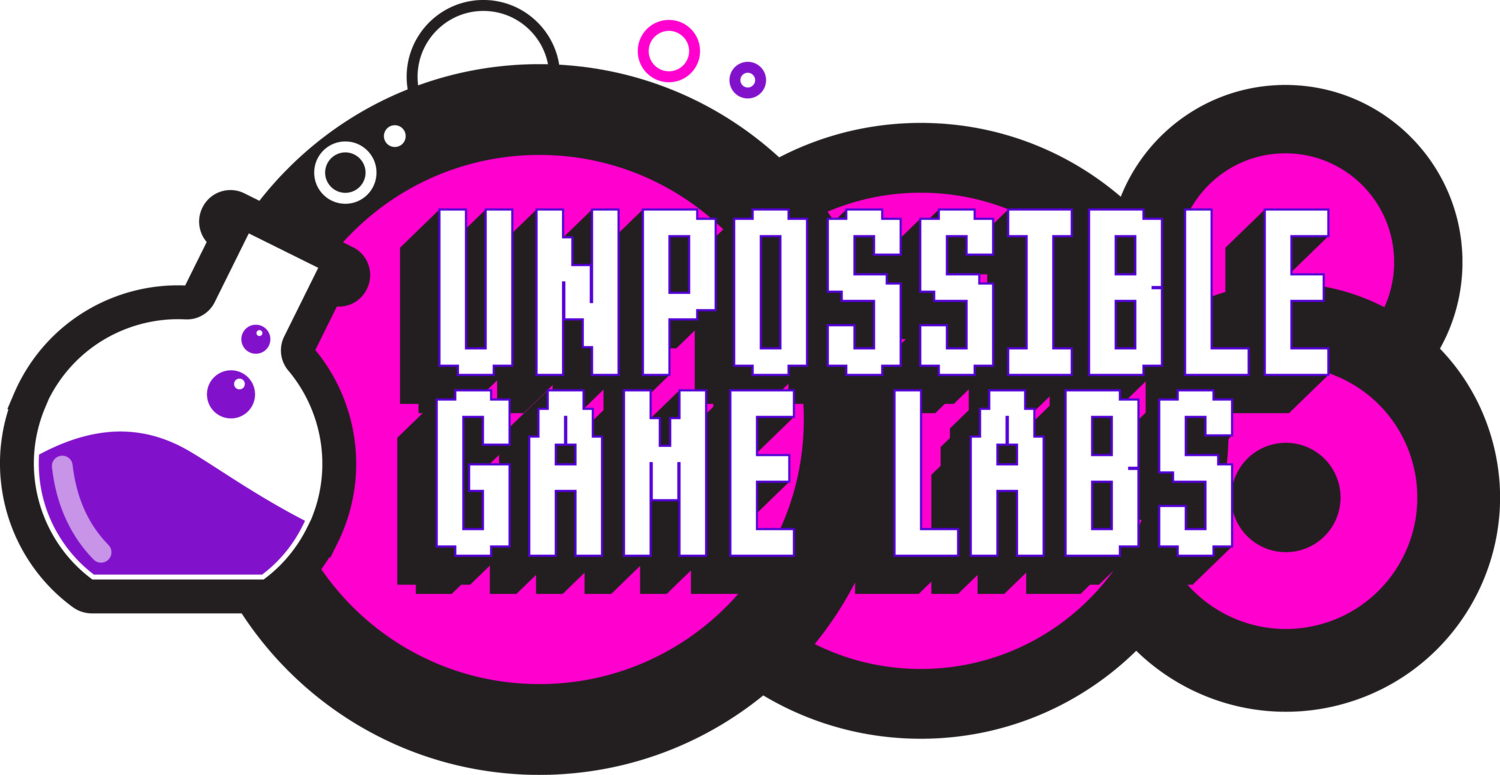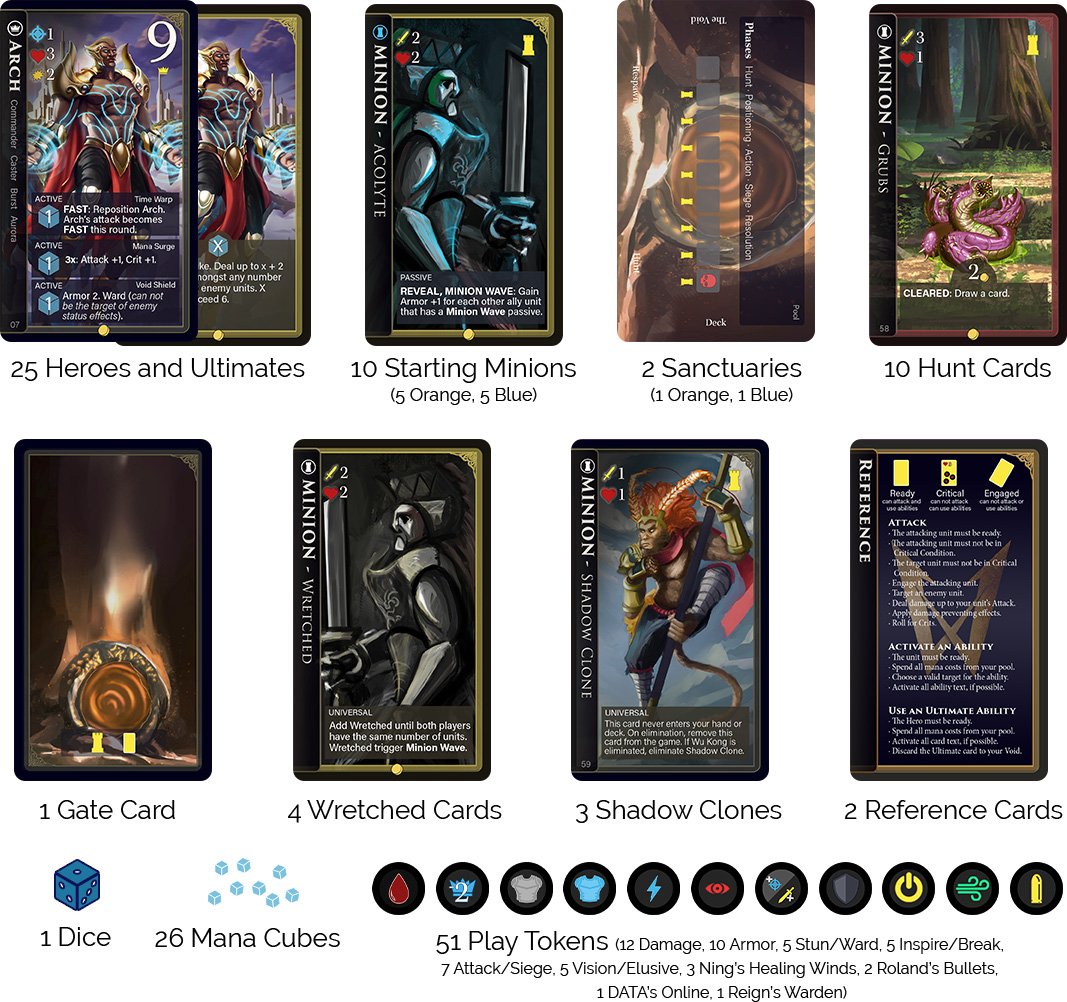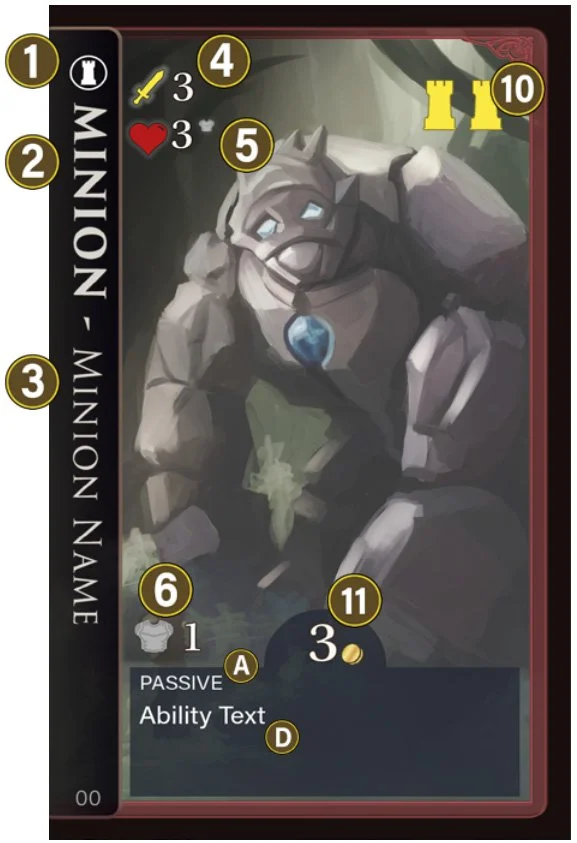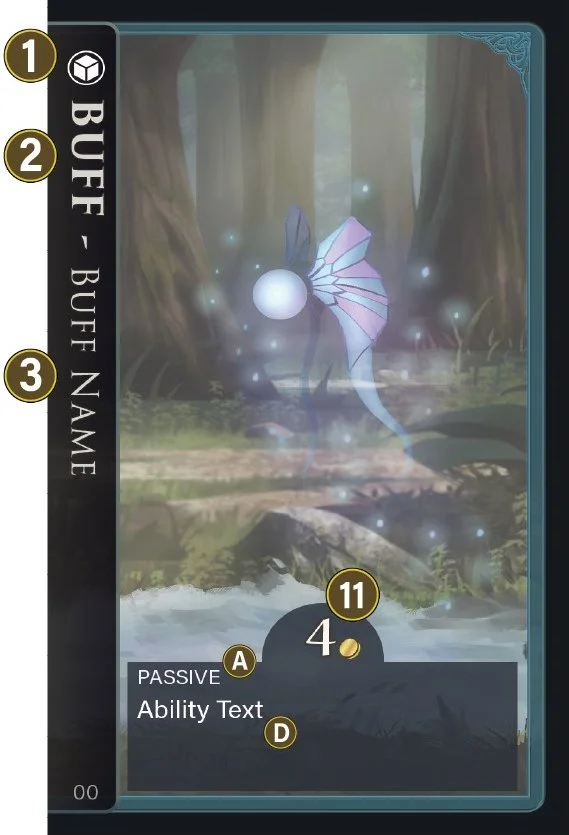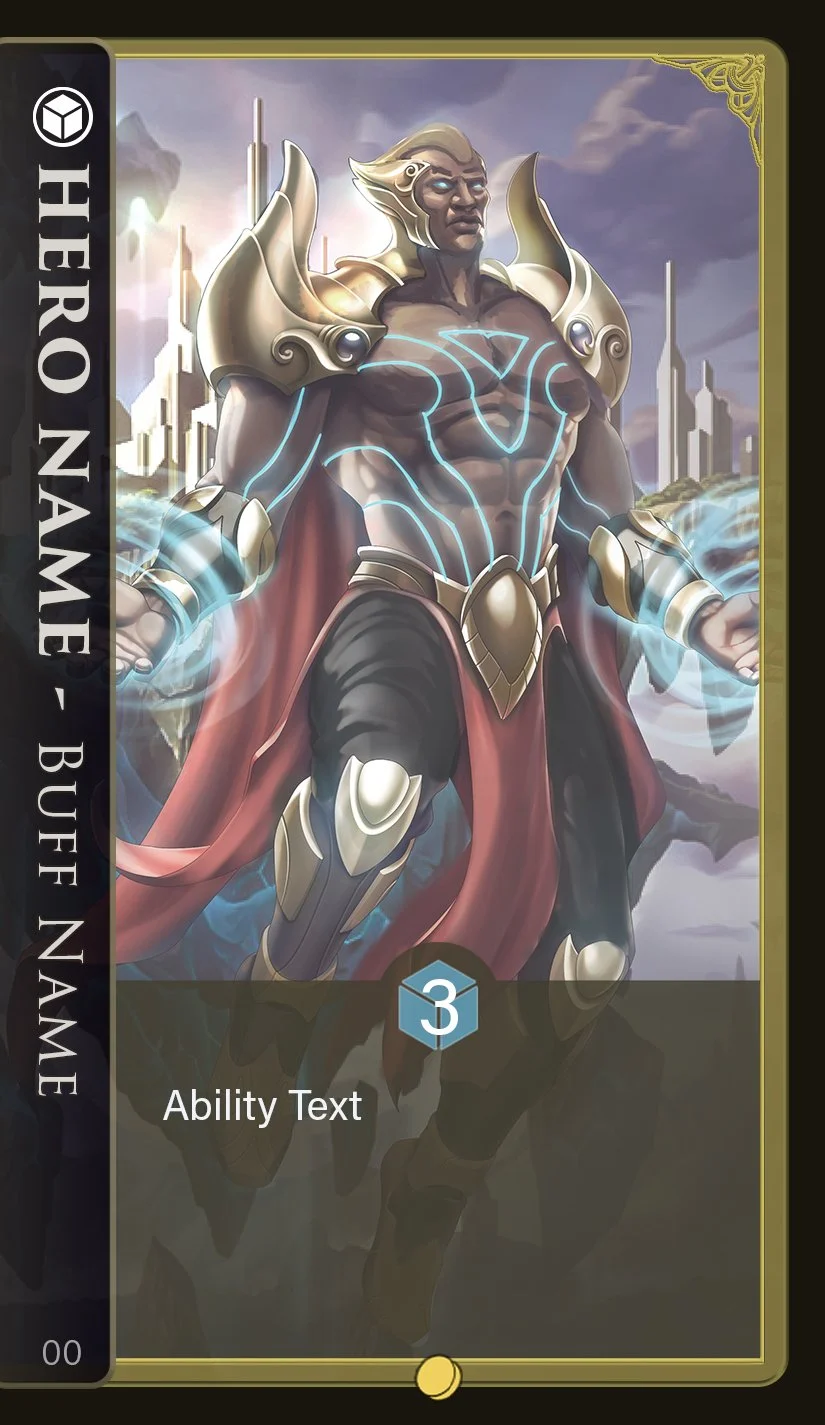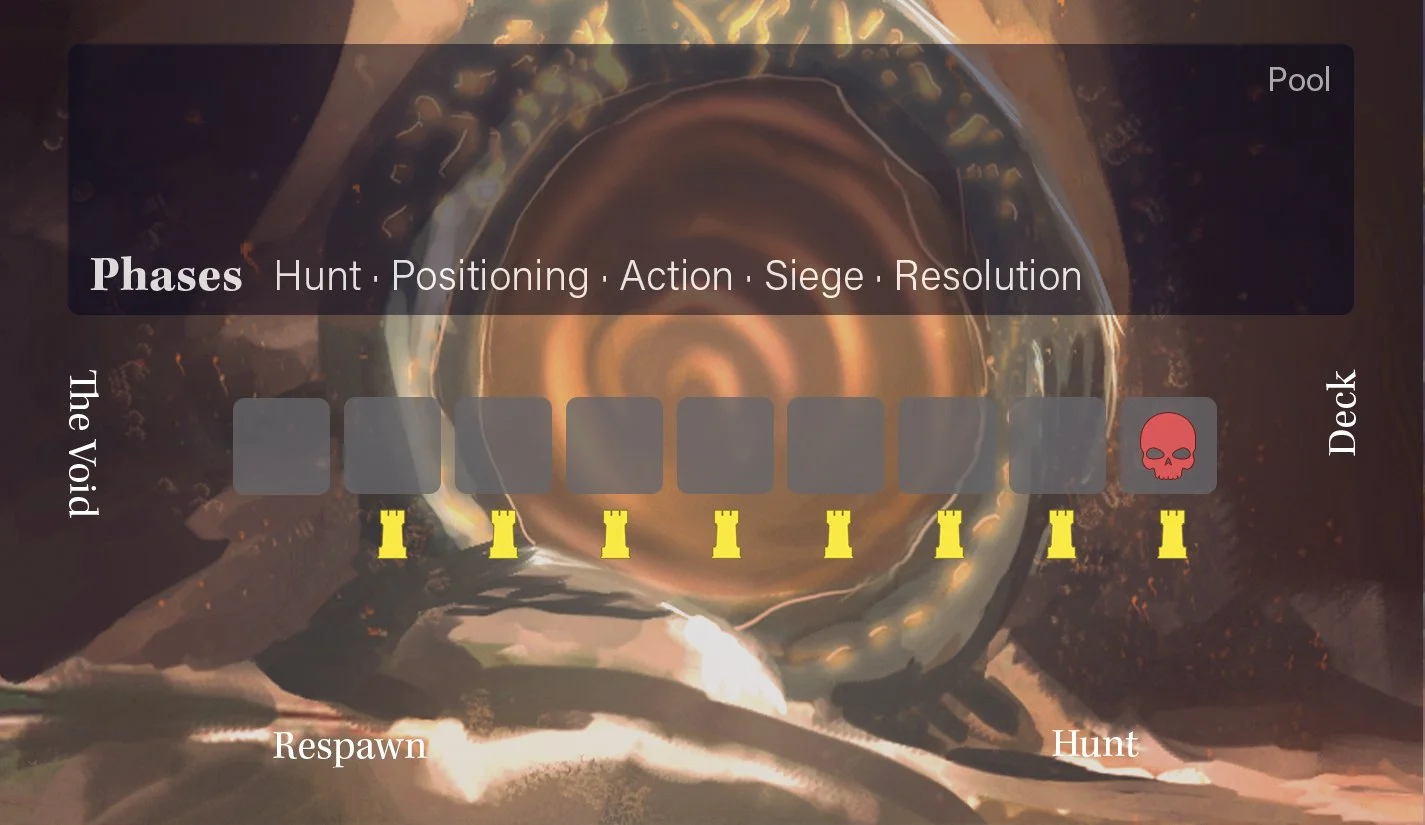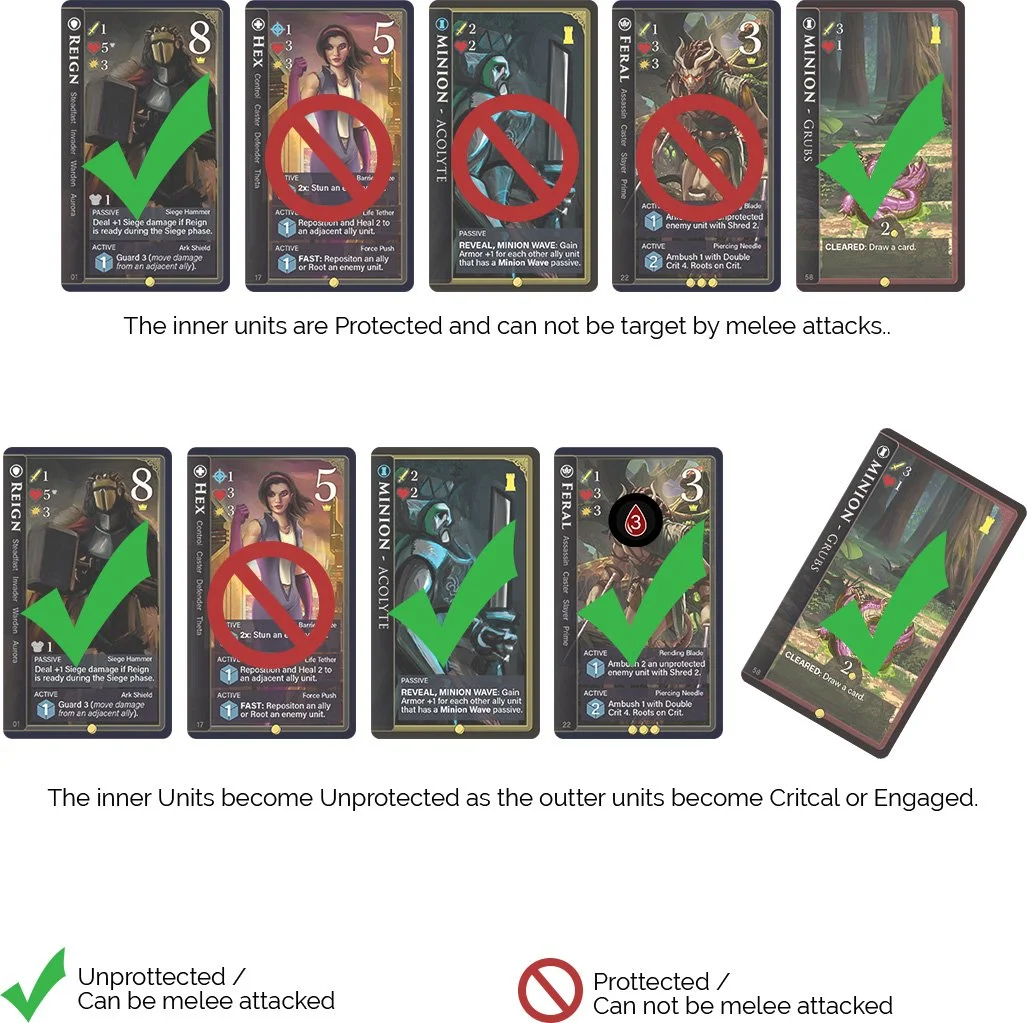Overview
In Ark Worlds, 2 players battle each other using an evolving line of 5 Heroes and Minions from their team. The first player to reduce the opposing player’s Sanctuary to 0 health wins.
Components
Unit Cards
Units are Heroes and Minions. During the Positioning Phase, you will choose and place 5 units into a row in front of you to form your Line. Units are used to attack and play special abilities against your opponent.
fig 1. Hero Card
Heroes
Every Hero has a black border and a unique name.
Each Hero comes with a powerful Ultimate card.
Surviving Heroes will contribute to your Control score.
When you play Heroes to your Line or to Hunt they return to your hand at the end of the round.
You lose access to eliminated Heroes for 1 round.
Most Heroes cannot damage the enemy Sanctuary directly, only other enemy units.
Heroes come in 5 classes:
Captains - Have high control values and varied abilities which can help you shape a strategy
Supports - Have abilities focused on healing or status effects.
Damage - Have very low control values but high damage output from attacking or abilities.
Blockers - Have attributes and abilities which prevent your other units from taking damage.
Hunters - Have high hunt values for gaining cards from the Hunt area. Hunters often can add supplemental damage when played to your line instead.
Minions
Players begin with 5 starting Minions.
Starting Minions have gold borders, Hunt Minions have red borders.
During the Hunt Phase, you may play cards from your hand to gain additional Minions.
When you play Minions, they go to the bottom of your deck at the end of the round.
Your surviving Minions automatically attack the enemy Sanctuary at the end of the round.
Card Components
Class Icon: Captain , Damage , Support , Blocker , or Hunter .
Name: Unit or ability name.
Unit Hints: Keywords describing the unit.
Attack Type / Damage: Melee or Ranged and unit’s attack damage.
Health : Amount of total damage before the unit enters Critical Condition.
Armor : The number of Armor tokens this unit starts with (if applicable).
Crit : Number rolled against for a successful crit.
Hunt Value : Play the card during the Hunt Phase to gain new cards to battle with.
Control Value: When a Hero survives the round, add this value to your control score to determine who takes the initiative.
Siege Damage : Deal this much damage to the enemy Sanctuary during the Siege Phase.
Cost: Total hunt value required to take this card from the Hunt area.
fig 2. Hunt Minion Card
Unit Abilities
A. Type: Active (requires an action), Passive (happens automatically), or Universial (always in effect, even when the card is not in play.
B. Name: Ability name.
C. Cost: Cost in mana to play ability for an action.
D. Ability modifiers and text: see Keywords and Modifiers Reference for details.
fig 3. Buff Card
Non-Unit Cards
These types of cards are not played to the Line:
Ultimates
fig 4. Ultimate Card
Ultimate cards are gold-bordered cards with the matching art of their hero. They are Hero-specific abilities which are very powerful. Ultimates can often turn the tide of a round in your favor. Once an Ultimate is played, it is discarded to your deck and you will have to wait some time to get it back. This makes deciding when to play an Ultimate a very important decision.
For each Hero on your team, place their Ultimate(s) into your starting deck. You can pay an Ultimate’s mana cost to play it as an Action, so long as the matching Hero is in play and Ready.
Gate
fig 5. Gate Card
The two-sided Gate card displays the color of the controlling team. You will calculate control during the Siege Phase, which can cause Gate card to flip (see Siege Phase below). The player who’s color is showing (either orange or blue) is said to have initiative, and will take the first action in the phases of the round.
Sanctuary
fig 6. Player Sanctuary Card
The sanctuary card is used to track important game information. The sanctuary cards are double sided so you can arrange your cards as you prefer.
The center of the sanctuary card keeps track of your sanctuary’s health. If you sanctuary health is every full depleted, you immediately lose the game.
The bottom and side edges of the card mark where you placing cards to keep track of their current state.
The top of the sanctuary card provides a place for your pool (which contains tokens that persist between rounds) and has a reminder of the game’s phases.
Setup
Choose player colors (blue or orange).
Place the Sanctuary card matching your color in front of you. Place 1 mana cube on the left most box of your Sanctuary card. This tracks your Sanctuary’s health. Designate a space in front of you to act as your pool (The top of your Sanctuary card has space for your pool) and place 2 mana cubes in your pool. Mana and tokens in your pool persist between rounds.
Players simultaneously choose 5 Hero cards. Players decide how they want to choose Heroes: a draft, random draw, etc...
(Note: we recommend taking 1 Hero from each of the 5 classes.)
Take the Heroes’ corresponding Ultimate card(s).
Take the Minions corresponding to your player color (blue or orange).Combine your 5 Hero cards, the Acolyte minion, and 1 of the Sage minions to form your starting hand. Set aside.
Shuffle together the Ultimate cards, 1 Sage, and 2 Zealot Minions facedown to form your starting deck. Place your deck to the side of your Sanctuary as indicated.Form the Hunt Deck from the Buff cards and red-bordered Minion cards. Remove 1 “River Wisp” and 1 “Grubs” cards, and shuffle the remaining Hunt cards to form the Hunt Deck. Place the Hunt Deck to the side of the Play Area. Place the Wisp and the Grubs to the right of the Hunt Deck to form the Hunt Area. Place the Gate card And a pile of “The Wretched” cards to the left of the Hunt Deck.
Add up the control value of all Heroes on your team. The player with the higher total has the initiative and will play first. In case of a tie, the player with the single highest control value (then second highest, etc) has the initiative. Flip the Gate card to the color matching the player who has initiative.
Place all remaining mana cubes and tokens in supply piles accessible to both players.
Playing The Game
Ark Worlds is played in rounds. Each round is made up of 5 phases: Hunt > Positioning > Action > Siege > Resolution
Hunt Phase
During the Hunt Phase, you can play cards from your hand to gain new cards from the Hunt Area. You and your opponent will alternate taking hunt actions until you both pass consecutively or there are no more cards in the Hunt Area.
The player who has initiative takes the first action (their team color will be showing on the gate). On your turn, you may pass or clear a camp:
Clearing a camp allows you to add new Buffs and Minions to your hand. To clear a camp, choose a card in the Hunt Area you would like to take. Play one or more cards from your hand with a total hunt value that equals or exceeds the chosen card’s Cost. You can only Hunt for 1 card per turn. No hunt value will carry over to your next clear camp action.
Activate any HUNT abilities on the cards you played from your hand. Activate any CLEAR abilities on the card you are taking, then set the cleared card above your Sanctuary until the end of the phase. Set the cards you played from your hand below your Sanctuary in the area marked Hunt.
If you pass, you will take no action, allowing your opponent to hunt again.
Once all players have passed or all Hunt cards have been cleared, you may now add any cards you cleared to your hand. Any Buffs or Minions you played are moved to your Void. Any played Heroes remain in the Hunt section of your Sanctuary.
Position Phase
In this phase, players choose their units to play.
Players simultaneously select 1 to 5 units (Heroes or Minions) from their hand and place them face down in a row to form their Line. If you have no units in hand, you immediately lose the game.
Once both players are ready, flip over all the cards in your Line, preserving their positions. All of your units are considered Ready at this time, which means that they will be free to take action in the following phase.
If one player should have fewer cards than their opponent (only during this phase), add “Wretched“ cards on either side of that player’s line until both players have the same number of cards in play.
Execute any REVEAL effects on cards. Place Armor tokens on any units with an Armor value.
Action Phase
During the Action Phase, players take turns attacking, using abilities, and playing Ultimates to eliminate their opponent’s units.
The players will take turns performing up to 2 actions at a time until both players pass consecutively. The player whose color is face-up on the Gate card, takes the first action. Note: The first player to start a round only performs 1 action their first turn.
On your turn, perform 1 or 2 actions from the following choices: Use an ability, attack, or play an Ultimate.
Use an Ability
You may activate an Active ability on a unit. If the ability has a mana cost, you must first pay that cost in full. Move the indicated amount of mana from your pool on to the unit. Place the mana inside the ability's text box.
Leaving spent mana on abilities will remind you of which abilities have already been activated this round. Unless otherwise noted, abilities may be used only once per round. You must completely resolve an Active ability before starting another action.
To use an ability:
The unit must be Ready (not Engaged or stunned).
Spend the cost as shown on the ability.
Choose a valid target for the ability:
Friendly: Targets a unit in your line, including itself.
Enemy: Targets a unit in your opponent’s line.
Self: Targets the acting unit.
Ally: Targets a friendly unit that is not itself.
If no target is specified, the unit may only target itself.
Resolve all effects in the text block.
Passive abilities are always in effect as long as the card is in play and do not require actions. Universal abilities are always in effect, even when the card is not in play. Passive and Universal abilities must be resolved when applicable if possible.
Abilities will often have 1 or more modifiers. These affect when and how the abilities may be used, They are as follows:
Cleared: Perform the indicated effect when the card is cleared during hunting.
Hunt: Perform the indicated effect when the card is played for hunt value during the Hunt Phase.
Reveal: Evaluate this effect at the end of the Positioning Phase, from your left to right, after units are revealed.
Fast: Using this ability does not count as a use of your 2 actions. You may perform as many fast actions on your
turn as you can afford to.
Slow: This ability may not be used if the unit is in Critical Condition. This unit may not take another action this turn or have already taken an action before this ability, this turn.
#x (2x, 3x): This ability may be activated up to # times instead of once. Using this ability more than once at the same time is considered 1 action when targeting the same unit(s). Note: The full mana cost is spent for each use of the ability.
Attack
Attacking lets you use a unit to deal damage directly to any enemy unit.
In order to attack:
The attacking unit must be Ready.
The attacking unit must not be in Critical condition.
The enemy unit must not be in Critical condition.
Turn the attacking unit 45 degrees clockwise. This unit is now Engaged and not Ready.
Target an enemy unit. Ranged attacks can target any unit, while Melee attacks can only target units that are Unprotected (see protected and unprotected below).
Deal damage up to your unit’s attack value to the target unit. Any damage that is not prevented is placed on the attack target.
If the attacking unit has crits, roll for bonus damage after their attack (See Crits below).
Play an Ultimate
Play an Ultimate card from hand and pay the associated mana cost to activate the printed ability.
To play an Ultimate:
The named unit must be Ready.
Pay the mana cost, discarding the mana from your pool.
Resolve all card text, if possible.
Discard the Ultimate card to the Void side of your Sanctuary.
Other Actions
Instead of taking any actions you may:
Pass: Forfeit your actions and allow your opponent to take another turn. If your opponent also passes, move on to the Siege Phase. On your next turn, you may continue to take actions as normal or pass again. You can pass on your turn as many times as you like, but once your opponent also passes, the game immediately progresses to the Siege Phase. Note: passing does not skip end of turn effects like updating status effects or eliminating critical units.
Retreat: Immediately end the entire round, skipping your turn, and forfeiting your Siege Phase.
Protected and Unprotected Units
When targeting enemy units, those units will be either protected or unprotected. A unit is considered protected if at least one unit to both the left and right of it are Ready and not in Critical Condition. Otherwise the unit is considered unprotected. units on the far left or right of your line are never protected.
Damage, Critical Condition, and Unit Elimination
Attacks and abilities may deal damage to units. When dealing damage to a unit, that unit may have effects that reduce the amount of damage taken (like Armor or Elusive). All damage reduction must be applied to incoming damage.
Each Armor token on a unit reduces incoming damage by 1, and then is discarded. Any damage that was not reduced by effects is considered “placed” damage, and is placed on the target unit for the rest of the round. It will remain there until damage is removed by an effect (like Heal or Guard) or the unit is eliminated.
If any of your units has damage equal to or greater than to their health, they are in Critical Condition (shortened, Critical).
At the end of your turn (after Passing or taking your actions), eliminate your units that are Critical. Move eliminated units to the Void. For each eliminated unit, your opponent receives a mana cube from the supply. If a Hero was eliminated your opponent also draws a card.
Critical Hits
Critical Hits (shortened Crits) can occur on Attacks and abilities. Attacking units with a Crit value adds a point of damage on a successful crit roll. To check for Crit damage, roll a die. If the value of the die roll is equal to or less than your crit value, add a point of damage to the attack or ability damage.
Siege Phase
During this phase, both players have the opportunity to damage their opponent’s Sanctuary. Reminder: players who Retreat during the Action Phase do not take part in the Siege Phase.
During the Siege Phase, perform the following steps:
Each player totals the Control numbers on the upper right corner of their Heroes in play.
The player with the highest Control total gains the initiative, flipping the Gate card to their color (in case of a tie, the Gate does not flip).
Starting with the player who has initiative, deal 1 damage to the opponent’s Sanctuary for each Siege damage you deal or tower symbol on your played cards (including the Gate). For each damage dealt, your opponent slides the cube on their Sanctuary card 1 space to the right. If this moves the cube into the right most space, they lose.
If your opponent has not lost the game, they deal damage to your Sanctuary. If neither player has lost, move to the Resolution Phase.
Resolution Phase
Prepare for the next round as follows:
Remove all tokens and spent mana from the play area.
Discard all of your Minions from, left to right, to your Void.
Take any Heroes left in the Play Area, or under your Sanctuary that Hunted or Respawned into your hand.
Move any units with Relentless from the Void to your hand. Move all other Heroes from the Void to Respawn below your Sanctuary (they will respawn next round).
Flip the remaining pile of cards in your Void face down, and move them to the bottom of your deck without changing the order of the cards.
Draw a card from your deck. If the Gate shows your color, draw an additional card.
Prep the Hunt Area by adding cards from the Hunt Deck until there are a number equal to the current round plus 2. (Example: At the end of the first round, add cards to the Hunt Area until 3 cards are present.)
Both players should gain an amount of mana equal to the current round plus 2 and add it to their pool. At no point can a player have more than 12 Mana in their pool.
The Golden Rules
If any of your rule printed on a card contradicts a rule in this manual, follow the rules on the card.
If unsure about how a card works, choose an interpretation that would have the least amount of impact. For example a rule that says “Gain +1 Attack” would grant +1 attack to that unit and nothing else.
If a rule in this online manual contradicts a rule printed somewhere else, always follow the rules as stated in this online manual.
Optional Rules
Random Draft - At random deal out 2 cards from each class (Captains, Supports, Blockers, Damage, and Hunter) to each player. Each player then discards 5 heroes leaving a team of 5. Continue with setup as normal.
Tournament Draft - First, players should decide what color they will be playing (blue or orange). To draft, the blue player selects any 1 hero from the current pool. The Orange player then selects 2 heroes. The blue player selects 2 more heroes (3 in total). The orange player selects 2 more heroes (4 in total). The blue player selects their final 2 heroes. The orange player selects their final hero. Continue with setup as normal.
Mirror Draft - If you have access to 2 copies of Ark Worlds, each player may choose their team from their copy independent of their opponents. This will allow for mirror matches where bother players have 1 or more of the same hero on their respective teams.
Hero Bans - Before selecting heroes, starting with the orange player, select a hero from the deck and put it to the side. That hero may not be chosen by either player this game. The blue player then selects a hero and places it to the side. That hero may not be chosen by either player this game. Continue on to drafting using either the tournament, random, mirror, or standard drafting rules.
Last Hits - When a Minion is eliminated, if that minion had taken damage exactly equal to it’s health, your opponent may gain 2 mana instead of the normal 1 mana.
Blitz Mode - Want a slightly faster game? Change setup in the following ways for punchier, more dynamic game.
Both players take 2 tower damage and start with 5 mana.
Shuffle all of your minion cards into your deck. Draw 3 cards. If you drew no minion, put your cards aside and draw 3 more. Shuffle the first 3 cards back into your deck.
Add a copy of “The Reborn“ to the Hunt Area.
Every round both players gain 5 mana and refill the Hunt Area to 4 cards.
Keywords and Terms
Abilities
NB: X represents the maximum output of an effect. “Heal 3 from friendly units” will only ever remove 3 damage in total. “Each friendly unit Heals 3” would remove 3 damage from each unit you have.
Ambush X - Deal X damage to a single enemy target that does not have Vision.
Armor - Remove an armor for each damage taken and discard that damage.
Break - This unit has -2 Control. This is a status effect.
Bury - Target unit takes damage equal to their health minus the amount of damage tokens they have on them.
Cleanse - Remove all negative status effects from the unit.
Cleave X - Deal X damage to the units adjacent to the target of this effect or attack. This is not considered to have “targeted” those units.
Crit X - Roll a die and deal 1 damage to the target if the die roll is equal to or less than X.
Double Crit - Crits deal 2 damage.
Elusive X - Reduce all instances of damage by X amount.
Enraged - Take 1 Siege damage if this unit is ready at the end of your turn.
Guard - Move damage dealt last turn from an adjacent unit to this unit.
Heal X- Remove X damage total among targets units.
Inspire - This unit has +2 Control.
Lifesteal - This unit heals 1 for every damage placed by this attack or ability.
Relentless - This unit returns to your hand when exiting the Void.
Reposition - Place target unit in any position in their line.
Root - Until the end of your turn, targeted unit is considered unprotected. Ignore Vision and Elusive modifiers on this unit. This is a status effect.
Save - Target a unit in Critical Condition. Heal 1 that unit until it is no longer Critical.
Shred X - Remove X Armor from the target before any other damage is dealt from this ability or attack.
Strike X - Deal X damage to a single enemy target. Not prevented by Vision.
Stun - Target unit is not ready until the end of the controlling player’s turn.
Vision - While ready, this unit may not be the target of an Ambush.
Ward - Enemy status effects may not be applied to this unit.
X With Y - The target must be a valid target of X, in order to resolve Y.
Timing
Cleared - Perform the indicated effect when the card is cleared during hunting.
Hun - Perform the indicated effect when the card is played for hunt value during the Hunt Phase.
Reveal - Evaluate this effect at the end of the Positioning Phase, from your left to right, after units are revealed.
Fast - Using this ability does not count as a use of your 2 actions. You may perform as many fast actions on your turn as you can afford to.
Slow - This ability may not be used if the unit is in Critical Condition. This unit may not take another action this turn or have already taken an action before this ability, this turn.
#x (2x, 3x) -This ability may be activated up to # times instead of once. Using this ability more than once at the same time is considered 1 action when targeting the same unit(s). Note: The full mana cost is spent for each use of the ability.
Targeting
Friendly - Targets a unit in your line, including itself.
Enemy - Targets a unit in your opponent’s line.
Self - Targets the acting unit.
Ally - Targets a friendly unit that is not itself.
Hero/Minion - May only target the specified type of units.
Unit - May target either Heroes or Minions.
Attributes
Abyss - In the game’s lore, this Hero has ties to the Abyss, a plane between worlds where a fallen dark gods waits.
Assassin - Hero is able to do a large amount of direct damage with abilities.
Aurora - In the game’s lore, this Hero has ties to the Aurora, world of floating isles powered by magic.
Brawler - Hero relies on a high attack damage.
Burst - Hero scales by spending a lot of mana in one turn.
Caster - Hero scales with access to mana.
Commander - Hero has a very high Control value.
Control - Hero has abilities that can control the board through status effects and repositioning.
Defender - Hero has or can grant defensive buffs to team mates.
Elusive - Hero has elusive or can evade being targeted.
Enforcer - Hero is able to spread damage across a lot of units.
Harasser - Hero is hard to get rid of or does many small abilities to create pressure.
Initiator - Hero has good opening play abilities.
Invader - Hero’s abilities add to Siege damage.
Medic - Hero can heal a lot of damage.
Mobility - This unit has the ability to reposition after revealing.
Netherworld - In the game’s lore, this Hero has ties to the Netherworld, world of the dead and sometimes demonic.
Prime - In the game’s lore, this Hero has ties to the Prime, world of the feral lands and wild mutations.
Ranger - Hero relies on high range attack damage.
Reaper - Abilities scale with the units entering the void.
Slayer - Hero has abilities that are highly effective against armored or high health units.
Steadfast - Hero’s abilities are useful late in a round.
Tactician - Hero has abilities that improve minions.
Tempo - Hero requires time to activate.
Theta - In the game’s lore, this Hero has ties to the Theta, world of futuristic technology and super-powered meta-humans.
Utility - Hero is able to buff or improve allies.
Visitor - In the game’s lore, this Hero has ties to one of the fringe worlds that has not yet been revealed.
Vitality - Hero self heals.
Warden - Hero has abilities that can lock down opponent’s options.
See an issue with the rules? Kindly report it.
Credits
Design & Direction Orion McClelland
Art Emily So, EJ Dela Cruz, Arthur Azaryan, Orion McClelland
Publishing Orion McClelland
Rules Copy Vas Kottas, Travis D. Hill, and Orion McClelland
Rules Edits Travis D. Hill and Regina Chen
Video Production Orion McClelland
Software Engineering and Infrastructure Orion McClelland
